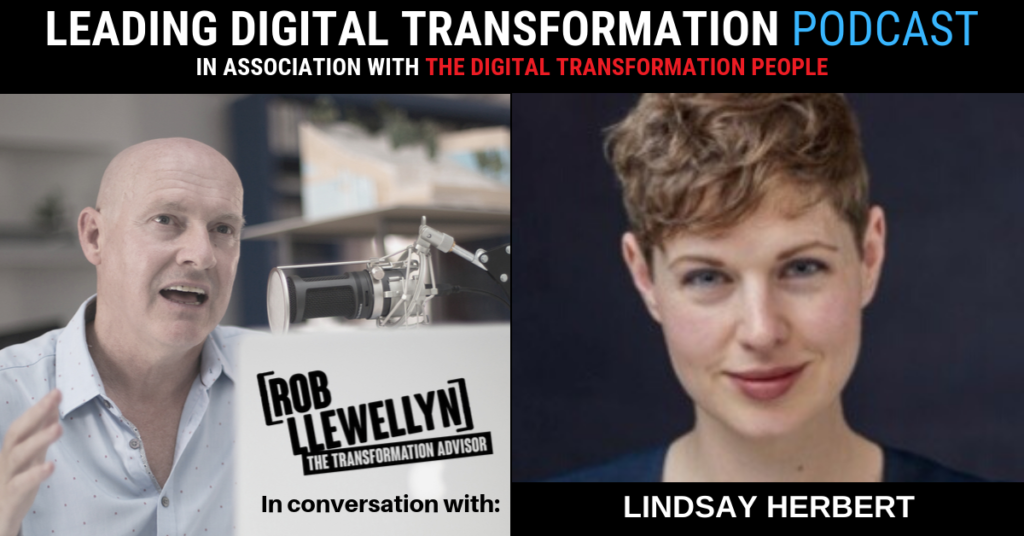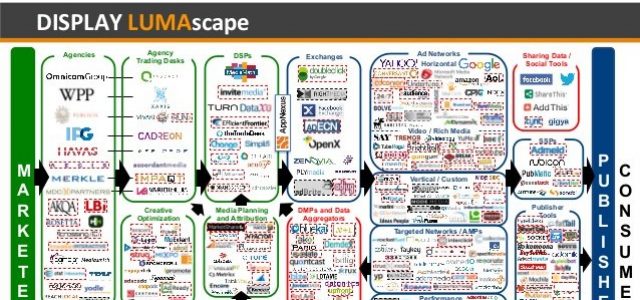‘Leading Digital Transformation’ is a weekly podcast series produced in collaboration between The Digital Transformation People and Rob Llewellyn digital transformation advisor and founder of CXO Transform.
During this series, Rob interviews experienced practitioners, authors and thought leaders whose stories and experiences provide valuable insights for digital transformation success.

In this episode, Rob interviews Lindsay Herbert, author of the acclaimed book ‘Digital Transformation’, keynote speaker and Inventor and Innovation Leader at IBM IX.
“A lot of people talk about the “why” of transformation and innovation, but fewer talk about how to get it done. In this podcast, Lindsay shares some of her insights on the “how” ~ Rob Llewellyn
Listen here and read the full transcript below.
Rob Llewellyn [00:00:21] Hi it’s Rob Llewellyn here and welcome back. A lot of people talk about the why of transformation and the why of innovation but fewer talk about how to get it done. Today we’re joined by Lindsay Herbert who is the author of the book ‘Digital Transformation’ published by Bloomsbury. Lindsay is going to share some of her insights with us on the how. Particularly in terms of Innovation. Let’s jump into the call with Lindsay. Lindsay, welcome!
Lindsay Herbert [00:00:51] Thanks, Rob. Thanks for having me.
Rob Llewellyn [00:00:53] Lindsay great to have you on the call. Thank you so much for making some time. Before we get into depths of digital transformation, I mentioned you published a book back in 2017. Tell us why you wrote a book on the subject.
Lindsay Herbert [00:01:05] So it’s a funny story actually. I had been leading major digital innovation type projects for my whole career basically at that point, leading up to that point, and I had learned the hard way what the best practices were versus some of the worst practices for trying to scale innovation across a complex and large organization. The idea for the book, in particular, came when I was on a train journey, I was going to conference in Oxford and I was in a terrible state of mind because a project that I had been leading, for a major charity, was going terribly. Also it’s every project, every nightmare you can imagine on a big innovation project was essentially happening on this project that I’m ultimately responsible for, and I decided that rather than just wallow I was going to use the train journey to try to diagnose what had gone wrong starting with the very beginning and as I started to jot down the problems that had been occurring since day one I started to get flashbacks to a different project which was actually for a completely different sector, different client different time in my career. But a lot of the problems that had happened from the outset were almost identical on this other project. And so that’s when I realized I might have something of value. I decided to do a different exercise which is to list off all the traits, the commonalities of the projects that had gone brilliantly and before I knew it. I didn’t just have two different lists, that weren’t opposites either, but I also was able to start doing some grouping. Things that were typical of an early stage, things that were typical of the mid-stage etc. By the time I got off the train, I knew I had the beginnings of some form of framework, some form of methodology, that could be used by an organization to lead innovation in the right way. But it was only informed by my own experiences and I wasn’t happy with that I wanted to make sure that this wasn’t my own perception and judgment clouding what could end up being a useful framework for other people. So I thought what’s the best way to validate this? I need to reach out to others, I need to find out, you know, not just from other agency side people like I was at the time but people who are leading innovation within an organization, you know, different geographies et cetera. I said well if I approach them as you know with my digital agency hat on they’ll think I’m just trying to sell them something. So I need to be able to come across like an independent – I know I’ll write a book! And so basically from the moment of getting on that train stepping off the platform and arriving at that conference I decided that I was not only going to write a book but I even started introducing myself at the conference to people saying, ‘Hi I’m writing a book about digital transformation’ and for the people who I was particularly interested in hearing their stories I’d offer them an interview and it just so happens that the person who is the keynote speaker at that conference ended up being my first official interview that made it into the book. That kind of kicked off three years of interviews, of research, getting to speak to some really brilliant, amazing people from all around the world to validate – and funnily enough that list that I first came up with wasn’t far off the mark. You know it’s amazing how many commonalities there are. Across these different digital transformation type projects that people only realize in hindsight are ‘best practice’. So you know my goal with the book, my goal with my own career was to stop making it a process of hindsight and start giving people something that they could use as a framework that would be flexible within the constraints of their own organization and their own goals, but not have to learn through trial and error. But yeah, a fateful train journey to Oxford. That was what inspired the book!
Rob Llewellyn [00:04:32] Yeah I was just thinking that was quite a defining train journey for you.
Lindsay Herbert [00:04:37] Exactly, exactly. You know when I’m lucky enough to have been able to publish the book with Bloomsbury and J.K. Rowling, of course, is another famous author with Bloomsbury. And I know that she formed the idea for Potter on a train journey so I like to think that’s just another common point between J.K. Rowling and I.
Rob Llewellyn [00:04:55] Lindsay – digital transformation. I mean before we get down into some detail tell us what’s your perspective on digital transformation. There are many different views and definitions of it. What’s your definition of what is digital transformation?
Lindsay Herbert [00:05:07] Such a good question because I actually tell people not to use the term because there’s so much disagreement about what it means and the problem with something a term like a digital transformation is that people think that it’s a specialized digital technology kind of term and they don’t want to admit that they’re not sure what it means. Cement it with whole meanings, you know you’ll have a boardroom of people nodding in agreement about a digital transformation program and everyone has a different idea in their head of what they’ve just agreed to. That’s really dangerous. So for. The simple definition the truest definition is a digital transformation just means to become adaptive to change itself. Now, people then challenged me and say well that’s just the change program. And I say well the digital part comes in from the fact that you can’t adapt to change anymore without leveraging data without leveraging new technologies and without adopting new ways of working – namely being collaborative and iterative. Those are the ways of working brought about by the Internet age, the Innovation age. So if you want to become adaptive to change it is a major step-change for most organizations because most major organizations are set up to standardize, to optimize, to bring down costs, to focus on efficiency not to focus on what’s happening on the outside world and how they need to be constantly adapting and reacting to the changes that are coming in especially the changes that are happening in really small early stages. Where you’ve got a chance to adapt and react to it early before it becomes a threat before it becomes a missed opportunity. But that is my core definition of digital transformation. It’s just being adaptive to change.
Rob Llewellyn [00:06:44] So based on your answer I guess you’d agree that it’s a kind of a dangerous buzzword. Yeah.
Lindsay Herbert [00:06:50] Oh God. The most common talk that I give the title of the talk is ‘digital transformation is a dangerous buzzword’. So I completely agree!
Rob Llewellyn [00:06:59] And why. Why do you think it’s so dangerous for organizations? You know when we’re talking about transformation, we’re not just talking about leadership teams. We’re talking about that wider workforce. Why do you think it can be a dangerous buzzword Lindsay?
Lindsay Herbert [00:07:12] So I think it’s three things. So firstly I alluded to already it’s the fact that people are on a leadership team might think they’re in agreement about a direction of travel when they’re actually not. You know the CEO is talking about digital transformation and she thinks that it means upgrading legacy platforms. The chief marketing officer is talking about digital transformation but they really just being updating the website, you know. And meanwhile, you might have one person who thinks a bit in the true sense which is a whole overhaul in the culture the ways of working that they-, approaches to the business as usual you know. And if they’re the only ones who are thinking that, they are going to have a really miserable time when they start to break down the work that needs to be done and they realize that the people above them are thinking on much smaller more targeted scale. So I think that’s the first thing that makes it dangerous. I think the second thing is the fact that it’s got the word digital in it means that people think that it’s about technology and that you just need to do it once. You need to update all your technology and your digitally transformed. But all you’re really doing is setting yourself up for becoming-, for falling out of step with the world around you in the next two years, three years, however long your upgrade is going to last you for and then you get people starting to blame technology because they think ‘well we’ve already spent a fortune on updating all these systems and look we’re behind the curve again, we’re falling behind our competitors again, we must have made the wrong tech decisions’ you know instead of thinking about it in a bigger picture sense. But the third way it’s dangerous is the perception from the people working across the company in the non management, the non-leadership roles because they hear the term ‘digital transformation’ and they think automation – robots, A.I. you know ‘I’m going to lose my job’ ‘I’m going to be obsolete’ ‘I’m already feeling irrelevant because when people talk about the big challenges that are facing the company they’re already linking them to big data and A.I. and algorithms and I don’t know how to do that. I’m in trouble’. And of course, the truth is that no piece of technology works without humans involved at the heart, training it, utilizing, it making it better. And the people who are best positioned to do that are the ones who are doing the day to day jobs already. They need to feel like they’re being brought along on this journey and that their roles are being evolved but they hear the term ‘digital transformation’ and they do not think that that’s what’s going to happen. Instead, they start putting in for stress leave requests with H.R. and searching for new jobs and thinking they have to go back to university and all those things are wrong. So yeah those for me the three reasons why it’s such a dangerous password.
Rob Llewellyn [00:09:37] OK so what should people talk about instead of digital transformation.
Lindsay Herbert [00:09:43] So the key thing is, look at the changes that you’re actually facing. Look at the big problems that you’re actually facing and talk about those. What’s driving the big changes? So that those could be changes in behaviours of the customer base you’re trying to serve. Could be changes in the market landscape, could be issues that you’ve been facing as a company historically for the entire time you’ve been in operation but those issues are costing you more and happening more regularly than they have in the past you know. So talking about it as tangible things that will have a human benefit and a human impact if you resolve them if you learn to cope with those changes in a better way that’s what’s going to get people understanding the real value in a digital transformation program as opposed to focussing on the technology which is just going to make people feel alienated. But absolutely it’s what are the big challenges? What are the big opportunities? The thing to be careful of though is don’t focus on the minutia. It’s not about optimizing and tweaking and improving your existing digital experiences. You know another talk I like to give is called ‘Death to digital experience’ and the reason for the title is I say that you know 10 years ago consultants and you know folks in different industries used to make a lot of money off being able to advocate that companies focus on improving their digital experience because ten years ago a lot of companies didn’t have a digital experience to offer their customers. So just telling them to offer one was a big transformational leap. Today, companies have so many digital experiences that they offer that they can make a full-time job of just optimizing those and it distracts them from the bigger picture that they’re missing out on. And it distracts them from the bigger opportunities for innovation that they think they’re doing a bang-up job because they’re focussing so much on digital. So I think that’s the key thing. Focus on the big challenges, the big problems, but the human element of them – not just the time that that human spends interacting with the screen that you happen to be offering them an experience on.
Rob Llewellyn [00:11:43] Lindsay you mentioned a really keyword that innovation. Of course, again in a way there are many ways to approach transformation. There are many different ways to approach innovation. What’s the wrong way to do innovation.
Lindsay Herbert [00:11:56] So the wrong way to do innovation is to get obsessed with a particular new type of technology and try to find the use case for it. I mean it is like becoming obsessed with hammers and just searching around everywhere to find something to hammer. The other thing is to focus too small because you know it goes back to the whole idea of what’s the difference between innovation versus optimization. Optimization is you’ve got an existing product and existing service and you’re just gonna tweak it to make it better, more efficient, cheaper, faster what have you. Innovation is you’re looking at the human experience end to end and you’re looking for an opportunity to drastically improve that human experience. You know I give an example in one of my talks of agriculture and that it’s really easy to focus on the farmer, you know, the customer at the end of the agricultural sector experience you know the farmer. But the farmer isn’t just interested in a better tractor these days, the farmer is interested in big data, how to optimize their crops, how to sell for better price on global markets, how to improve the genetics of the crops that they grow so that they can get a higher yield for lower inputs you know. There are massive big human experience problems to solve for a farmer. So if you’re in an agricultural company the worst thing you could do is make a better tractor. The best thing you can do is look at that bigger picture and to address the bigger picture. You’re going to have to work with other companies you’re going to have to have partners you’re going to have to form a network. You’re not going to solve a big challenge on your own that the true heart of innovation is in doing something that’s going to be beneficial for that human at the end of the experience not just for making it easier for you to sell your existing product or service.
Rob Llewellyn [00:13:32] Okay so Lindsay, if I was representing an organization that was you know very keen as most organizations are to undergo transformation and they understood that innovation was core to transformation I was coming to you and so Lindsay tell me the right way to do innovation what would you tell me?
Lindsay Herbert [00:13:50] I think the first thing you need to do is go right back to the core purpose of your company. And unfortunately, a lot of companies mistake their mission statement with just a list of products and services that they offer. If you really go right back to the core purpose, the true mission statement of a company, what you’ll end up with is a problem statement that does relate to the human experience or the world as a whole. It’s not something-, it’s the reason why people felt inspired to join the company in the first place. You know what keeps people motivated to keep going even when times are tough. You know that’s the core purpose of the company. And then it’s about really drilling down to what are the people we need to be able to serve and engage with in order to deliver that core purpose? Are they the people we’re engaging with now? Are we aware of the other people who are fulfilling needs in that same space. And then once you’ve sort of identified that core purpose – get out of the company! Stop having internal meetings, stop having internal brainstormings, go out engage with the people you’re actually meant to serve, find unique ways to bridge the gaps that have formed with those outside influences you know and that can be finding out what’s happening in the tech sector sure but it’s also finding out what other people are doing to serve the needs that you’re meant to be serving that might not feel directly related to your products or your services yet. So it’s about being creative it’s about getting out and forming what your next steps could be to start bridging that gap. You know it’s going back to the question if your company was founded today, how much different would it look? How would it do things? And I don’t just mean about optimizing. I mean if you were trying to fulfil the same core need would you do it differently and that’s your opportunity to start experimenting with different approaches. You don’t need to completely turn the company on its head and shut down all your existing products and services but it’s an opportunity to start experimenting the same. Maybe there is an opportunity for a new business model. Maybe there’s the opportunity for a whole new area of need that we can deliver to because we’ve actually overlooked some assets that we’ve got within the company or some capabilities we’ve got within the company. So that’s the critical first and then what I talk about in the book I actually go through five stages in total but that first stage is the most important because it’s the part that opens your eyes to how much of a gap is formed between your company and who it’s meant to serve.
Rob Llewellyn [00:16:13] So is that the whole purpose of getting outside the company Lindsay so that you can understand what that customer wants more? What’s the real benefit in getting outside the company?
Lindsay Herbert [00:16:25] Absolutely. So what I have-, the analogy that I use in the book is to say you know the captain of a ship doesn’t take the weather readings from below decks but we’ve got this horrible habit within companies of not only do we immediately revert to sending business analyst to all of our different departments to gather up requirements so that, you know, under the illusion that somehow the people who have been in the company for the longest, you know, the management group usually, people who have been in the company for the longest are somehow magically going to know what’s happening in the greater, outside world when we know for a fact that they’ve been incentivized to focus very myopically on their existing practices, existing processes and just making those more financially beneficial. Right. So you don’t take your weather readings from below deck if you want to know what’s going to happen next, if you want to know where you’re going and you want to get a glimpse through those unchartered waters you have to think beyond the existing constraints of the company, the operational model you’re running within etc.. And it’s not only to get inspiration. It’s also to figure out where those major problems are that have been overlooked for a long time because it’s very easy for people to overlook problems and you know areas where they’re really under-delivering because they’re focussing on the metrics that have traditionally been valued and incentivized within the company. So those are really the two things. The other bit too is to start to form connections with people outside that it could help, you know. So I always say innovation starts with a worthy problem, a problem that other organizations other individuals outside of a company would be willing to want to help solve because it’s not just about one product or one service. It’s about again that human experience. You take your worthy problem and you start introducing it to tech companies you start introducing into academics, you start introducing it to different groups and before you know it you’ve actually got people willing to collaborate on something truly innovative because you’re tackling something that does go bigger than just your normal business as usual. That’s where you get the real opportunity for transformation. So it’s in part you know figure out where you need to be going next. Figure out where your major problems are. But then also get the potential for other collaborators and people who can help you on this transformation journey and actually really move the needle. That’s I think the three real reasons why you want to be doing that first step.
Rob Llewellyn [00:18:57 Lindsay, I want to go back to your train journey and actually your book. In the process of writing your book, and I’m sure it was a huge amount of work. What was the most interesting finding you made on the actual journey of writing your book?
Lindsay Herbert [00:19:09] I think the biggest thing was that every conversation I had with all these brilliant people who were change leaders and company leaders from all over the world. Every conversation I had felt like a therapy group because everyone has you know-, real innovation is hard. It is-, It’s not hard because of the technology- the technology is the easy part. It’s hard because of the people change that’s required. And you know I tell a story for example about Harvard University and how the chief digital officer who is one of my interviews for the book, the chief digital officer wanted to have Harvard be one of the first higher-ed institutions to have an iPhone app when the iPhone was first on the market. And she was trying to hire an iPhone app developer but she wasn’t getting any job applicants through. So she talked to the people from H.R. looked at the job ad that had been posted and saw that it was requiring five years experience minimum! This is just a device that’s only been introduced to the market and the H.R. people said yes we know but the salary you want to offer, the seniority you want to give this position, policy dictates that it has to have five years minimum experience. And she faced a choice at that point. She could have either just gone around it you know hired contractors, hire freelancers, a lot of us have been in that boat before and we’ve taken the easy route out and hired freelancers. But she realised she would have been short-changing her ability to drive innovation going forward. So she put in the hard work working with the leadership team, working with H.R. to change the policy. And that’s what real innovation is, so that’s the biggest thing in common I think with everyone I spoke to and the most shocking insight from doing all the research was that people want to share these stories because there is pain and hardship attached! But at the end it’s so worth it because if you’re doing real innovation and you see the real benefit to the people at the end of it it’s the most rewarding thing you can do. But yeah definitely it feels like a therapy group. We talk about it.
Rob Llewellyn [00:21:09] Love that H.R. story and policy.
Lindsay Herbert [00:21:13] And that’s the thing that people don’t think about, right. And you know what my second-, So like I said I have five stage in the book the second stage is about barriers uncovering barriers because barriers to innovation hide in plain sight. They’re embedded in the culture, they’re embedded in the ways of working and the rules and the way people are incentivized et cetera. So, but if you just do the first stage and you get your clever idea and how you want to go about trying to solve it you don’t address barriers as your second stage the people you put in charge of whatever innovative piece is being done they’re going to just spend the next year banging their heads against walls because they’re going to run up against policies and rules and regulations and resource shortages and whatever else. So if you don’t pave the way properly for them, then you’re not just not going to get your innovation at the end you’re going to lose a lot of really great people because it’s one of the most disheartening things to be put in charge of a new innovation type project and realize that you have nothing but internal meetings and red tape ahead of you when you should be able to focus on building something collaboratively that’s actually going to help someone. So yeah, the H.R Harvard story is one of my favourites too for that reason.
Rob Llewellyn [00:22:17] Lindsay we could go on but we’re going to have to wrap it up because of time. Thank you so much for your insights. Before you go. You’ve shared so much with us and I know there’s a lot that you’ve also shared in your book. Tell everybody where they can learn more particularly about the five steps and where they can find out more about the insight that you have to share.
Lindsay Herbert [00:22:37] Yeah absolutely so I always suggest people follow me on LinkedIn. I produce a video series every Friday called ‘Fridays answered questions‘. I’ve just finished the first series and I’m working on the second series right now. But it’s basically answering all the frequently asked questions that I get when I give talks on innovation which is all the time so I get a lot of frequently asked questions. And so I address those in a little video clip every week on LinkedIn. I also do the same on Twitter so my Twitter handle is @Digital_Lindsay. So can find me there as well. And I think to find out more about the five steps pick up a copy of the book really because that’s where I put all of the methodologies, all the insights, all the case studies and that’s available worldwide on Bloomsbury’s Web site, on Amazon. You know all your usual suspects.
Rob Llewellyn [00:23:18] And the book is called Digital Transformation, correct Lindsay?
Lindsay Herbert [00:23:21] Yes that’s right. ‘Digital Transformation‘ published by Bloomsbury and the subtitle is ‘Build your organization’s future for the innovation age’.
Rob Llewellyn [00:23:30] . OK great. Lindsay, It’s been a pleasure. Thank you so much for your time.
Lindsay Herbert [00:23:33] Thanks Rob.
VO [00:23:36] We hope you enjoyed this episode of leading digital transformation with Rob Llewellyn and The Digital Transformation People. Visit The Digital Transformation People to secure the knowledge, talent and services you need for digital transformation success. To continue your journey as a certified transformation professional visit RobLlewellyn.com.
Be sure to subscribe to the podcast and follow us on Twitter @TheDigitalTP and @RobertLlewellyn.
Article by channel:
Everything you need to know about Digital Transformation
The best articles, news and events direct to your inbox
Read more articles tagged: Change & Transformation, Featured, Leadership, Talent






